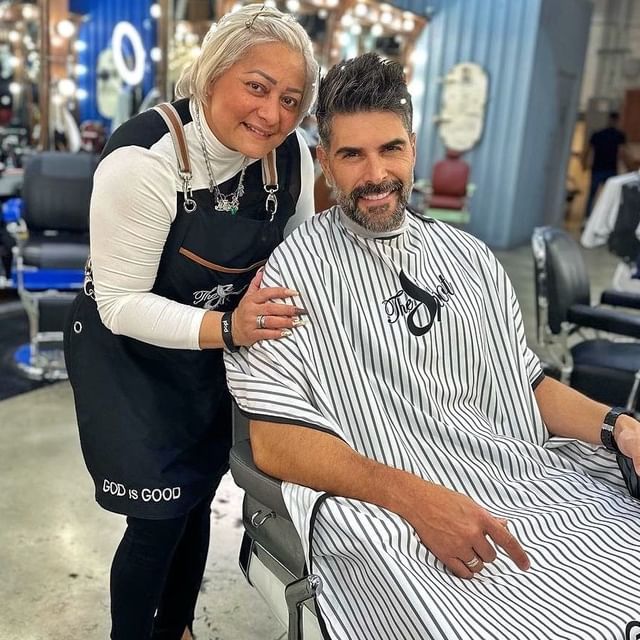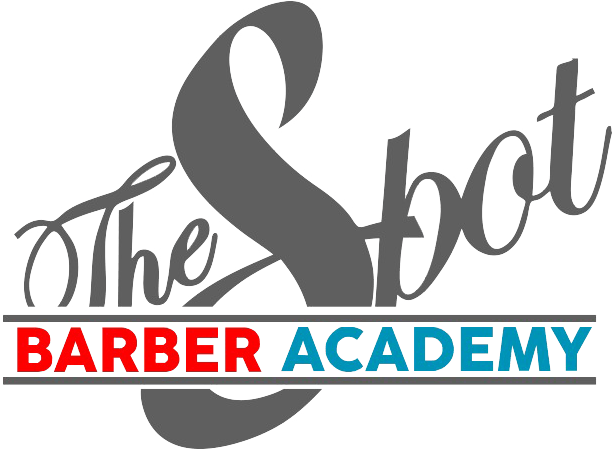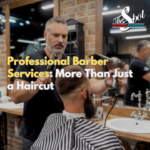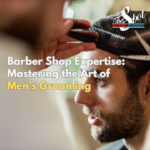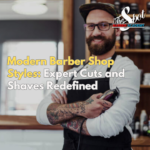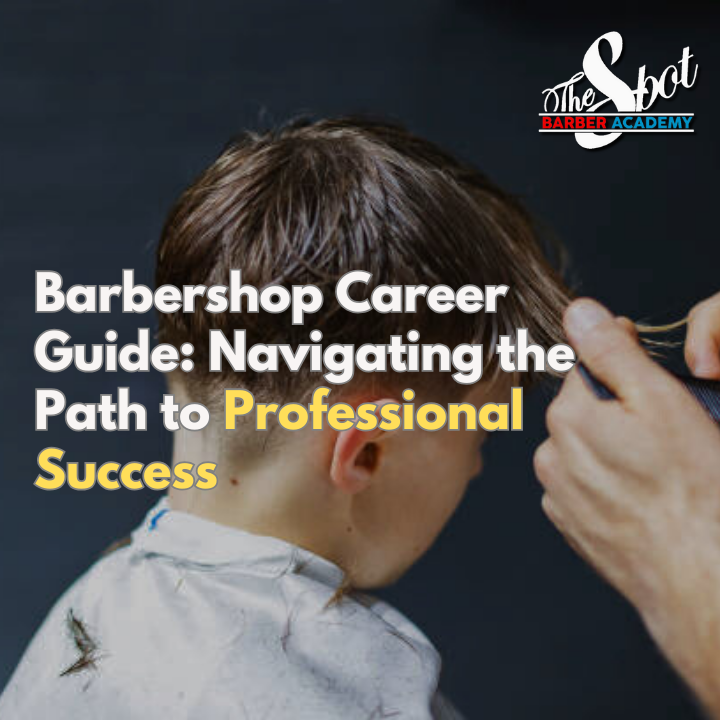Introduction
Embarking on a barbershop career can be a transformative and rewarding journey. With the right blend of skill, creativity, and business acumen, a career in barbering offers a unique opportunity to impact lives while expressing one’s artistic flair. This comprehensive guide will walk you through the essentials of navigating your path to professional success in the barbershop industry.

Steps to Launching Your Barbershop Career
Acquire Formal Education and Training
-
- Enroll in a reputable barber school. Education is crucial to learn the fundamentals of hair cutting, styling, and grooming.
- Look for programs that offer a mix of theoretical knowledge and practical training. This combination ensures a well-rounded skill set.
Obtain Licensing
-
- In many regions, a barber must be licensed to practice. Understand the licensing requirements in your area.
- Typically, this involves passing an exam that tests both theoretical knowledge and practical skills.
Gain Hands-On Experience
-
- Start as an apprentice in a barbershop. This provides real-world experience under the guidance of experienced professionals.
- Take advantage of opportunities to practice different techniques and styles. The more diverse your experience, the better.
Build a Professional Portfolio
-
- Create a portfolio showcasing your work. Include a variety of styles and techniques to demonstrate your versatility.
- Use before-and-after photos to highlight your skills. A strong portfolio is a key tool for attracting clients or employers.
Develop Interpersonal and Customer Service Skills
-
- Work on your communication and customer service skills. A barber’s interaction with clients is a significant part of the job.
- Learn to understand and anticipate client needs. This leads to better service and client satisfaction.
Stay Updated with Industry Trends
-
- Keep up with the latest trends in hairstyling and men’s grooming. The fashion and beauty industry is constantly evolving.
- Attend workshops, seminars, and trade shows. These are great for learning new techniques and networking.
Consider Specialization
-
- Think about specializing in a particular area, such as traditional shaves, modern haircuts, or beard styling.
- Specialization can set you apart in the market and attract a specific clientele.
Learn Business Management Skills
-
- If you aim to open your own barbershop, learn basic business management. This includes marketing, finance, and operations.
- Understanding the business side is crucial for running a successful barbershop.
Create a Strong Online Presence
-
- Build an online presence through social media and a professional website. This is important for marketing and client engagement.
- Regularly update your profiles with your latest work, promotions, and relevant content.
Launch Your Career
-
- Start by working in established barbershops to build a client base and reputation.
- Consider opening your own barbershop when you have enough experience and clientele.
In conclusion, launching a barbershop career requires a mix of education, practical experience, skill development, and business acumen. Following these steps methodically can lead to a rewarding and successful career in this dynamic and creative industry.

Skills Required for a Successful Barbershop Career
Technical Proficiency in Hair Cutting and Styling
-
- Mastery in various cutting techniques is fundamental. This includes understanding different hair types and textures.
- Styling skills are equally important. They enable barbers to create looks that match client preferences and current trends.
- Continuous skill enhancement is vital. Barbers should stay abreast of new techniques and styles.
Beard Grooming and Facial Hair Care
-
- Expertise in beard grooming is increasingly sought after. This includes trimming, shaping, and maintaining facial hair.
- Knowledge of facial hair products is also essential. Barbers should be able to recommend suitable products for their clients’ needs.
Strong Interpersonal and Communication Skills
-
- Effective communication is key. It helps in understanding client needs and preferences.
- Building rapport with clients is crucial. A friendly, approachable demeanor makes clients feel welcome and valued.
- Active listening skills are important. They ensure that client instructions are accurately followed.
Creativity and Artistic Flair
-
- Creativity allows barbers to tailor unique styles. This sets their service apart in a competitive market.
- An artistic eye helps in visualizing and executing hairstyles. This skill is particularly important for custom and avant-garde styles.
Customer Service Orientation
-
- Exceptional customer service skills are a must. They ensure client satisfaction and encourage repeat business.
- Handling client feedback, both positive and negative, is part of this skill set. It helps in maintaining a positive reputation.
Business Acumen and Management Skills
-
- For those aspiring to own or manage a barbershop, business skills are essential. This includes understanding marketing, finance, and operations.
- Time management and organizational skills are also important. They help in efficiently managing appointments and the daily running of the barbershop.
Adaptability and Problem-Solving Skills
-
- The ability to adapt to various situations is crucial. This includes handling unexpected challenges and changing client demands.
- Problem-solving skills help in resolving issues that may arise, ensuring smooth operations.
In summary, a successful barbershop career requires a blend of technical skills, interpersonal abilities, creativity, business knowledge, and adaptability. These skills not only ensure excellence in service but also contribute to building a loyal client base and a thriving business.
Understanding the Barbershop Industry
The Growth and Evolution of Barbering
-
- Initially, barbershops were more than hair care centers. They served as social hubs. Here, men would gather, engage in conversations, and enjoy a relaxing atmosphere. Over time, this role has expanded. Modern barbershops now blend tradition with contemporary styles and techniques.
- This evolution reflects changing customer needs. It also shows the adaptability of the industry. Today’s barbershops cater to a diverse clientele. They offer a range of services, from classic cuts to modern styling.
The Impact of Technology in Barbering
-
- Technology plays a pivotal role. It has transformed the traditional barbershop experience. For instance, online booking systems have made appointments more accessible. They have streamlined the customer experience.
- Advanced hair care products and equipment are also notable. They enhance the quality of services offered. Barbers now have tools that allow for more precision and creativity.
- Social media has become a powerful marketing tool. Barbers can showcase their work to a broader audience. This exposure helps in attracting a diverse client base.
Sustainability in Barbering
-
- Environmental consciousness is reshaping the industry. More barbershops are adopting sustainable practices. This shift is not just good for the planet. It also appeals to environmentally aware customers.
- Eco-friendly products are in demand. Reducing waste and conserving resources is becoming a priority. These practices set a barbershop apart in a competitive market.
Customer Preferences and Expectations
-
- Understanding customer preferences is key. Today’s clients expect more than just a haircut. They seek a complete grooming experience.
- Barbershops are adapting to these expectations. They offer a range of services. This includes skincare, beard grooming, and personalized styling advice.
- The atmosphere of the barbershop also plays a crucial role. A welcoming, comfortable environment can significantly enhance customer satisfaction.
Career Opportunities and Growth
-
- The barbershop industry offers diverse career paths. These range from being a stylist to owning a barbershop.
- Continuous learning is essential for growth. Barbers must stay updated with trends and techniques. This commitment to learning ensures career longevity.
In summary, understanding the barbershop industry requires acknowledging its history, embracing technology, prioritizing sustainability, meeting customer expectations, and recognizing the potential for career growth. This knowledge is crucial for anyone aspiring to enter or progress in this field.
Navigating Challenges in a Barbershop Career
Keeping Up with Industry Trends
-
- The fashion and grooming industry is constantly evolving. Staying updated with the latest trends is crucial for relevance and competitiveness.
- Regularly attend workshops and trade shows. Also, follow industry leaders on social media for inspiration and insights.
Managing Customer Expectations
-
- Clients may have specific or high expectations. Understanding and managing these expectations is key to customer satisfaction.
- Communicate clearly with clients. Ensure you understand their needs before starting any service.
Dealing with Diverse Clientele
-
- A barbershop sees a wide range of clients. Adapting to different personalities and requests can be challenging.
- Develop strong interpersonal skills. These will help you handle various types of clients effectively.
Balancing Creativity and Practicality
-
- While creativity is important, not all creative ideas are practical or suitable for every client.
- Find a balance between being creative and catering to what the client wants and what suits them.
Maintaining Physical Stamina
-
- Barbering can be physically demanding. Long hours on your feet and repetitive motions can lead to fatigue.
- Regular breaks and good physical fitness can help. Also, consider ergonomic tools and equipment to reduce strain.
Handling Financial Stability
-
- Income can fluctuate, especially for those who are self-employed or working on a commission basis.
- Effective financial planning and budgeting are essential. Diversifying income sources can also provide stability.
Building a Loyal Client Base
-
- Establishing a steady clientele takes time and effort. It’s crucial for long-term success.
- Provide exceptional service and foster good relationships with clients. Word of mouth can be a powerful tool.
Navigating the Digital Landscape
-
- Digital marketing and online presence are vital but can be overwhelming.
- Consider courses in digital marketing or seek professional help to effectively promote your services online.
Stress and Burnout Management
-
- High-pressure environments and demanding schedules can lead to stress and burnout.
- Prioritize work-life balance. Engage in activities outside work to unwind and recharge.
Continual Learning and Skill Upgradation
-
- The learning never stops in the barbering profession. New techniques and styles emerge regularly.
- Dedicate time for continuous learning and skill improvement to stay ahead in the game.
In conclusion, while a career in barbering offers numerous rewards, it also presents challenges that require resilience, adaptability, and continuous growth. By effectively navigating these challenges, you can build a fulfilling and long-lasting career in the barbershop industry.
Joining Our Barbering Program at The Spot Barber Academy
In conclusion, a career in barbering offers a world of opportunities for those with passion and dedication. If you’re inspired to embark on this rewarding journey, consider joining our Barbering program at The Spot Barber Academy. Our comprehensive curriculum, experienced instructors, and hands-on training approach are designed to equip you with everything you need to succeed in the vibrant world of barbering. Embrace your passion, refine your skills, and let us help you carve out your unique path in the barbershop industry.
